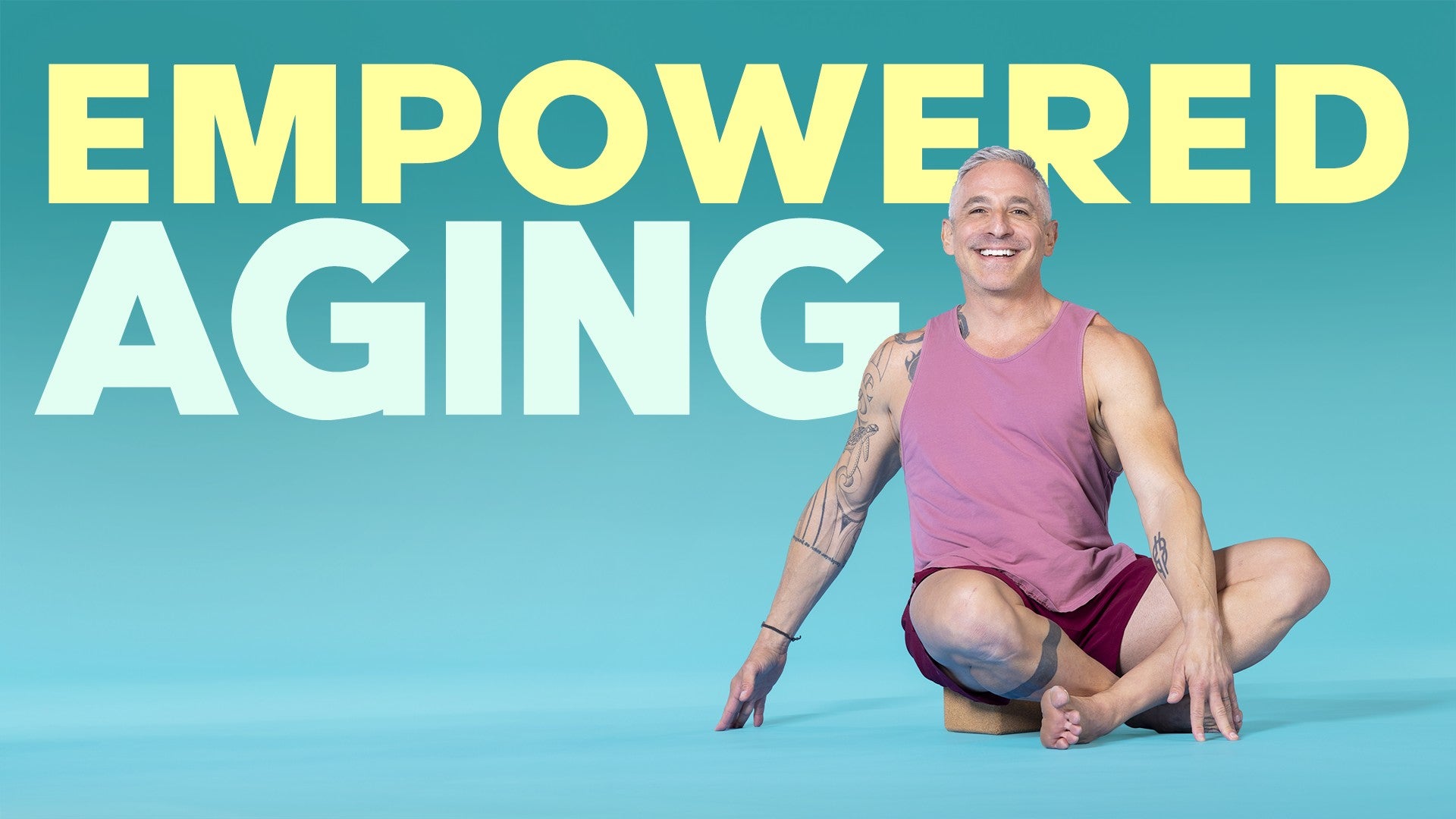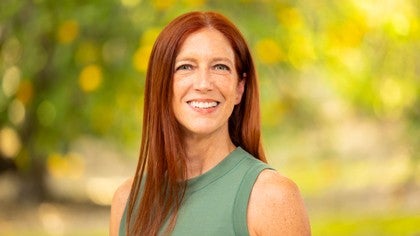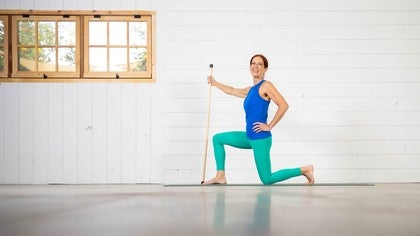Description
About This Video
Transcript
Read Full Transcript
Welcome to yoga for bone health. I'm doctor Sherry Betts, and I specialize in treating osteoporosis and spinal pathologies through yoga, pilates, and strength training. I'm excited to present information on dealing with osteoporosis or bone density issues with a yoga program. The World Health Organization established osteoporosis as a disease in 1994. 200,000,000 people worldwide have osteoporosis.
And 30% of US women have osteoporosis. 1 in every 2 and 1 in every 4 men. Over age fifty have osteoporosis. So it's likely that if you enter a yoga class that half of those people that are over age fifty will have low bone density. When you identify osteoporosis, you'll want to be looking for not just bone density, but you can identify it through height loss of greater than an inch a half, which can indicate that you've collapsed some of the vertebra in your spine.
You can also identify it through family history if your mother, father, family members have had osteoporosis you're more likely to experience it yourself. Also, if you've had a compression fracture or any type of fracture that results in a fall from a standing height that ends up in a fracture will indicate that you may have osteoporosis. Another concept to think about is the presence of a rounded upper back, a dowager's hump, or a forward head posture, of greater than 7 centimeters away from a wall if you're standing against a wall may also indicate that you've had a compression fracture in your thoracic spine. Lastly, a rib compression onto the pelvis where it diminishes the space between your ribs and pelvis may also indicate that you've had osteoporosis and a compression fracture. Your teacher can actually look at you and see any of those things. You can have a statiometer and measure your height, and you can also put your fingers between the ribs and pelvis and see if you've had any loss that results in less than two fingers in between the ribs and pelvis.
You can also stand against the wall at home and see if you can get your head to the wall without looking up toward the ceiling, and those may indicate that you need to address your bone health. Vertible fractures often come in different shapes. You'll find that there is a spontaneous compression fracture that results in sort of a pancake shape of the vertebrae. There's also a wedge type fracture that usually occurs when the spine is compressed in the front. It can occur with a sneeze or a cough and a rounded posture, lifting something with a rounded back, or just bending forward to touch your toes. Those are pictured in the slides that you'll see.
Now we can also identify a compression fracture using a side x-ray of the spine. And if you have a wedge shaped fracture in one area of the vertebra, the vertebra above and below are way more likely to fracture. You have about a fivefold risk for fracture after that first fracture happens. So the best thing is to try to prevent that first fracture and then certainly be very vigilant if you've had a fracture so that you prevent fractures of the vertebra above and below. What happens is the architecture of the spine changes so that the vertebra is compressed, and then that brings the spine into more and more curvature. There are people that have had several compression fractures, and only 20% of compression fractures are symptomatic, meaning that 80% of fractures that people have, they don't even really know.
Now when we look at yoga poses that may be risky for bending in that flexed posture, We might think about things like the standing forward fold with a rounded spine, seated forward fold, maybe the plow or the shoulder stand. That you'd wanna be vigilant about if you are at risk for osteoporosis or have low bone density. Sanaki and Mickelson did a really pivotal study in 1984, which is a very long time ago, very old research, but because of the nature of the research, it would be unethical to ask people to repeat that study because of the results of that study. What they did is they took 59 postmenopausal women and they divided them into 4 groups. Group 1 did a prone extension exercise with a pillow under the ribs. Gruit 2 did a crunch exercise where they're lying supine, and they're doing a little sit up.
Group 3 did both of those exercises, and group 4 did no exercise. When they evaluated the results of the study, They saw that 89% of the people who did the crunch exercise had additional compression fractures. Only 16% of the people that did the prone extension exercise had additional fractures. And then the people that combined both of those exercises had about they were about 50% of the people in that group that had additional fractures. The good news is that exercise combined with the right exercise combined with the wrong exercise is actually better than no exercise.
Because the people that did no exercise, they saw that 67% of those people had additional fractures. So the good news is that doing exercise is better than not doing exercise. Other points to consider about protecting your spine from fracture are going to be things like twisting to end range and especially using your arms to create overpressure at end range. That also results in a winding up of the ligaments of the spine and can compress the spine. Combined motions of rotation with flexion can also risk one for fracture.
And then a side bend, especially with a bouncing motion, can result in a fracture as well. So you'll want to avoid extremes of side bending, rotation, and forward flexion if you want to protect your spine from fracture. You'll also want to be mindful about going into the prone and making sure you use a pillow under your ribs when you do extension, which is indicated for osteoporosis and building bone in your spine, but you wanna protect those ribs from excessive force when you're lying prone. Now let's talk about the benefits of yoga for bone health. One of my favorite benefits of yoga is awareness.
And being mindful about your movement is going to be so helpful for prevention of fractures being aware of your posture, being aware of your body as you're as you're lifting things off the floor, really taking your yoga practice into your life. I like to think of it being like yoga off the mat. Another concept to think about is reduction of thoracic kyphosis. The research has shown many times that a yoga practice focusing on thoracic extension or backward bending type motions is actually effective for reducing that forward flex posture. It also can result in prevention of fractures and also building bone density.
Another concept in yoga that is not always addressed in many types of exercise programs is balance. There's so many poses that really challenge your balance and leg strength much more than any other mind body practice. We will address the principles of really helping with the foundational movements to support your bones as you enter into a yoga practice. At yoga anytime. We're going to address alignment of the body stacking the bones up from the feet to the pelvis to the rib cage to the head, using props like a dowel to help with reminders about your bones and where they're placed as you do certain movements.
That's gonna be one of the most important things that you'll learn is trying to be aware of your spine as you're bending forward, getting to the mat, getting up, and picking things up off the floor. Another principle that we might think about is leg strength. I mentioned earlier that leg strength was really important. And after age fifty, we lose about 1% of our leg strength every year, and that's coupled with about half a percent of bone strength every year after age fifty. So it's very important that we focus on our leg strength And that's one of the wonderful things about a yoga practice is there are so many poses that can help you with developing leg strength. We'll be doing things like warrior poses, tree pose, chair pose, transitions to the mat, the sun salutation series, which will also help with another principle called dynamic alignment.
Wanna think about moving through space with mindfulness, and great alignment. So those kind of poses that we'll be doing will be things like warrior 3, things like side angle pose, things like triangle pose and getting into the position without bending our spines. Then we wanna also think about how to keep our spine mobile. Bending over a ball or round surface is so helpful for improving your mobility of your thoracic spine, improving your posture as well, and we'll also do some safe rotational movements safe side bending movements and movements of the lumbar spine as well to help keep your bones and joints healthy and mobile. And not put them at risk for fracture.
Let's talk about exercise in general, thinking about what type of exercise is actually build best for building bone. Swimming, water aerobics, or Polo, cycling, and walking have actually been shown to be ineffective, not effective, for building bone density. Some of these practices actually have shown depletion of bone density. Water polos, swimming, aqua aerobics, and cycling have actually shown been shown to have detrimental effects on bone density. Running is a little bit controversial.
Running has been shown in some studies to build bone density if it's not too long of a distance, but long distance running has actually been shown to have detrimental effects on bone. We always wanna think about doing cardiovascular exercise as part of our regular routine, along with strengthening that can start with a yoga practice that helps to support the bones, support alignment, and learn how to put weight through the bones. And then we can start adding resistance training that's been shown to have great effects on the bones. So remember, you're trying to build a well rounded practice of overall health and well-being, and yoga can be a really integral part of that practice. There's some really important research from Australia going on right now that has shown great effects in postmenopausal women who are doing strength training.
They've studied not only the effects on bone density, but they've also studied the detrimental effects that could be happening. So there were some challenges with the dead lifts, the squats, the overhead press, the back squats, and then the pull ups with the drop landing. That people challenged Doctor Belinda Beck originally with her work because they thought that it would result in fracture. Well, that's not been the case. She's put hundreds of people through the trials called the Liftmoore trials.
And they have been shown to have a 3% increase in the spine on average and a 0.3% in the hip. Doing both high intensity strength training and also impact training. So meaning like a jumping or dropping from a high surface. And so we're really excited about that research, and it's something you could you could consider when you're ready for that bone loading program. Now when we refer to yoga research, I wanna talk to you about a systematic review that was really helpful with at letting us know some of the latest research and also how yoga has benefited bone health.
So it may not have shown that bone density was increased in most of the studies, but what they did find was that people fell less They improve their posture, they improve their quality of life, and they improve their strength. All of those things help to prevent fractures, which is the most important concept. Like, we don't really know how dense our bones are. We can't really sense that in our own body, but what we can sense is feeling strong, confident, balanced, and in control of our body. And that's really the point. Now let's talk a little bit more about safety and movement. There are a few other concepts to consider besides protecting your spine.
You'll want to think a little bit too about protecting your wrists, which the best way to protect your wrist is to practice balance, And then because the main way to have a wrist fracture is to fall onto outstretched arms. So if you practice your balance, you're much less likely to have a wrist fracture. And then with hip fractures, what we've seen in some case reports was that if someone crossed their legs, and sit up really tall like this and did something like a pigeon pose where they're putting a lot of weight through the neck of the femur. That has been shown in very small case reports to have an effect on the hip where if the hip was so stiff, that the person didn't have enough mobility, then the neck of the femur could fracture. But that is a very rare case.
And I usually just tell people that if you don't have a lot of hip mobility, you don't really wanna do the pigeon pose and there's putting full body weight down through the hip. And you can practice in a supported position where you're lifting the up onto a yoga block, or you can do it as I'm doing here sitting tall when you put your shoes on. My final concept I want to leave you with is to enjoy your practice. And the main thing is that you don't wanna afraid, you wanna feel empowered, and you want to enjoy your practice, whether it's a yoga practice or strength training, whatever it is that you're doing. Want you to look forward to your movement program.
I always say the fountain of youth is thoracic extension, balance, leg strength and hip extension. Hip extension is something that I didn't really mention, but it's when you bring your hip back into alignment and then be able to take a long stride forward because if you have good hip extension, you can walk with long strides, and you have less likelihood of falling. Thank you so much for joining me. I hope you learned something in the lecture and feeling aspire to join me on the map at yoga anytime.
Empowered Aging: Bone Health
Comments
You need to be a subscriber to post a comment.
Please Log In or Create an Account to start your free trial.







